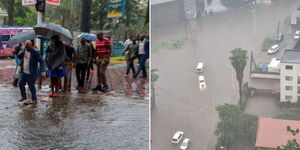On Wednesday, October 21, a photo of a precariously designed apartment building sparked a detailed conversation on the country's construction industry and some of the buildings in Nairobi that have raised eyebrows.
The origins of the viral photo of a building that was likened to the Titanic are yet to be established, but it soon revived talks of buildings in Kenya whose designs are questionable.
Poor structural design is listed as one of the major reasons buildings end up collapsing. A structural engineer can make errors in computation and fail to take into account the weight that a structure will be expected to withstand.
The engineer may also follow inaccurate theories and use inaccurate data and make wrong choices of materials during the construction of a building.
To compound the matter, research findings by the Anti-Counterfeit Authority (ACA), showed that in 2017 alone, Kenya lost Ksh129 billion to counterfeiting in the construction industry, growing to Ksh153 billion in 2018.
In an investigative feature aired on January 12, 2019 by Africa Uncensored, several Huruma Estate residents confessed to vacating their apartments whenever it rained, as they did not trust in the structural integrity of the building.
"When it rains I prefer to stay outside and only go back inside when it stops," one resident explained.
"I can't even dare to stay inside my house when it's raining," another added.
The resident's newfound fear came after the fateful night of April 29, 2016, when a six-storey building collapsed in the estate following a heavy downpour, resulting in the death of 51 people. Several others were left injured.
Eyewitnesses to the horrific incident narrated how slabs smashed into each other like a house of cards, with one resident revealing that the six-storey building with 257 rooms was built at record speed.
Similar incidents have occurred almost an annual basis, with Kenyans left questioning what the approval process for putting up a building entailed.
An audit conducted between January and February 2018 revealed that some 471 housed are unfit for occupancy. 217 buildings were marked for demolition, a majority of which are in Huruma.
According to the report, these are the most common causes of buildings collapse in Kenya:
Poor structural design was detailed earlier in this article.
Weak foundations
Adequate foundations are usually costly and depending on the strength of the soil and expected load of the building, they can contribute up to half of the entire cost of the building.
Some developers, however, want to save money when building on weak grounds by cutting on concrete and reinforcements resulting in the collapse of buildings.
Substandard materials
The Kenyan market is currently pervaded by counterfeit products and the construction industry has its fair share of these goods.
Unqualified labour
Such unskilled workers lack the technical know-how on construction processes and requirements such as the ideal standards of structural steel as well as the correct concrete mixing ratios and curing procedures for optimum strength in relation to the expected load of the complete building.
Greed for wealth
The influx of people into urban areas over the years has resulted in an ever-growing demand for housing in major towns across the country.
Corruption
For a few thousand shillings, corrupt inspectors are willing to turn a blind eye on malpractices resulting in fatalities and financial loss.
In March 2018, the National Construction Authority (NCA) released a draft study titled A Research on Failure and Collapse of Buildings in the construction industry of Kenya.
The report found that there is consensus amongst industry players that duplicity and overlap of development control functions spread over
government agencies, coupled with poor coordination of professionals are the underlying causes of building failures and collapses in Kenya.
The collapse of buildings in Kenya remains an intractable problem, and dates back 25 years, with the first major recorded case being the collapse of Sunbeam Supermarket along Moi Avenue in Nairobi’s Central Business District in 1996, which killed 35 people. Previously, a multi-storey building in Dagoretti had collapsed in 1990, killing one person and injuring a few others.
Kenyans have since taken it upon themselves to share photos of buildings deemed to be dangerous on social media, in a bid to alert the authorities and avoid further loss of lives.
Here are some more photos shared over the years:












